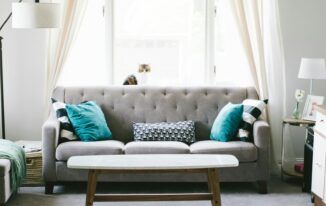Table of Contents
- The Importance of Cozy and Stylish Living Rooms
- Choosing the Right Furniture
- Selecting a Color Palette
- Incorporating Textures and Fabrics
- Lighting Matters
- Accessorize with Care
- Maximizing Space
- Final Thoughts
The Importance of Cozy and Stylish Living Rooms
The living room is the heart of any home, where families gather to spend quality time, entertain guests, and unwind after a long day. Achieving the perfect balance between cozy comfort and sophisticated elegance can transform your living space into a welcoming haven. Enhancing this room with pieces from Taylor’s Furniture can elevate both its functional and aesthetic appeal without making it feel like a showroom.

When designed thoughtfully, a living room can serve multiple purposes, from a quiet reading nook to a bustling social hub. Integrating various elements like furniture, colors, and lighting can significantly impact the room’s ambiance and functionality. So, how do you create a space that is both inviting and stylish? The answer lies in the details and the effort you put into harmoniously blending various design elements.
Choosing the Right Furniture
Choosing the right furniture is essential to creating a living space that is both stylish and comfortable. Opt for pieces that offer both function and aesthetic appeal. A plush sofa paired with versatile accent chairs can create a cozy seating area. Don’t forget the coffee table – it serves as a functional piece for placing drinks and decor but also ties the room together. The key is finding pieces that make a statement but offer long-term comfort and durability.
Size and Scale
Your furniture’s scale and size should complement the size of your living space. While too-small furniture may appear out of place, oversized items might give the impression that a room is crammed. Measure your space and consider the layout before making your selections. For instance, a sectional sofa might be perfect for a larger room but overwhelming in a smaller setting. Similarly, a petite loveseat could get lost in a spacious living area.
Selecting a Color Palette
The living room’s atmosphere is determined by the color scheme. Soft, neutral shades like beige, gray, and cream create a calm and inviting atmosphere, whereas bold colors can add character and vibrancy. Choosing a consistent color palette helps unify the different elements in the room, creating a cohesive look. Colors have psychological effects as well; light shades can make a room feel bigger and airier, while darker colors create a cozy, intimate setting.
Accent Colors
Incorporate accent colors through accessories like throw pillows, rugs, and artwork. These can be seasonal or trend-driven, allowing you to update the room’s look without major renovations. Accent colors can add visual interest and can easily be swapped out when you desire a new look, providing cost-effective flexibility.
Incorporating Textures and Fabrics
Textures and fabrics contribute significantly to a living room’s coziness and elegance. A mix of materials like velvet, wool, and leather can add depth and interest. A rich and hospitable environment is produced by layering various textures. For example, a velvet sofa can be paired with a wool rug and silk cushions to introduce varying tactile experiences and visual appeal.
Rugs and Drapes
Area rugs and drapes are excellent for adding texture. Choose rugs that complement your color palette and add warmth. Drapes can enhance the room’s elegance while providing practical benefits like light control and privacy. Heavy drapes add luxury, while sheer curtains maintain a light and airy feel. The options are endless, and the combination should reflect your style and the room’s overall theme.
Lighting Matters
Select warm-toned carpets that go well with your color scheme. Layered lighting, including ambient, task, and accent lighting, creates a warm and inviting atmosphere. To achieve equilibrium, use a combination of overhead lighting, table lamps, and floor lamps. For more lighting strategies, consider this resource on lighting strategies. Effective lighting can enhance the mood and functionality of your living room, making it adaptable for different activities.
Natural Light
Maximize natural light by using sheer curtains and strategically placing mirrors to reflect light into the room. Natural light enhances the room’s warmth and is a free resource you can take full advantage of. Position your furniture to make the most of windows and skylights. Not only does this make the room more inviting during the daytime, but it can also save on energy costs.
Accessorize with Care
Accessories like throw pillows, rugs, and artwork personalize your living room and enhance its aesthetic. Select items that go well with the color scheme and texture you’ve chosen. You may add vibrant art, bold vases, and even indoor plants to make your living space feel more alive. Accessory pieces let you add individuality to your space and are simple to swap out to update the room’s appearance.
Minimalism vs. Maximalism
Whether you prefer a minimalist approach with a few well-chosen pieces or a maximalist style with an array of decor, make sure every item has its place and purpose. Too many accessories can make the room feel cluttered, while too few can leave it feeling sparse. Experiment with different styles to find what works best for your space and reflects your personal taste.
Maximizing Space
Even small living rooms can feel spacious with smart layout planning. Multi-functional furniture like ottomans with storage or extendable coffee tables can enhance functionality without sacrificing style. Vertical storage solutions can also help free up floor space, making the room feel larger. Shelves, wall-mounted units, and even tall bookcases can provide much-needed storage without crowding the room.
Effective space planning involves carefully considering traffic flow and seating arrangements. Make sure there is enough room to move around comfortably without bumping into furniture.
Final Thoughts
Creating a cozy and elegant living room is about balancing comfort with style. Through thoughtful furniture selection, color choices, textures, and lighting, you can design a space that welcomes you and your guests with open arms. Taking these factors into mind will help you design a living room that genuinely feels like home, regardless of whether you’re beginning from scratch or remodeling an existing space. The idea is to create a haven for you and your loved ones, something that feels good to be in and looks nice.


